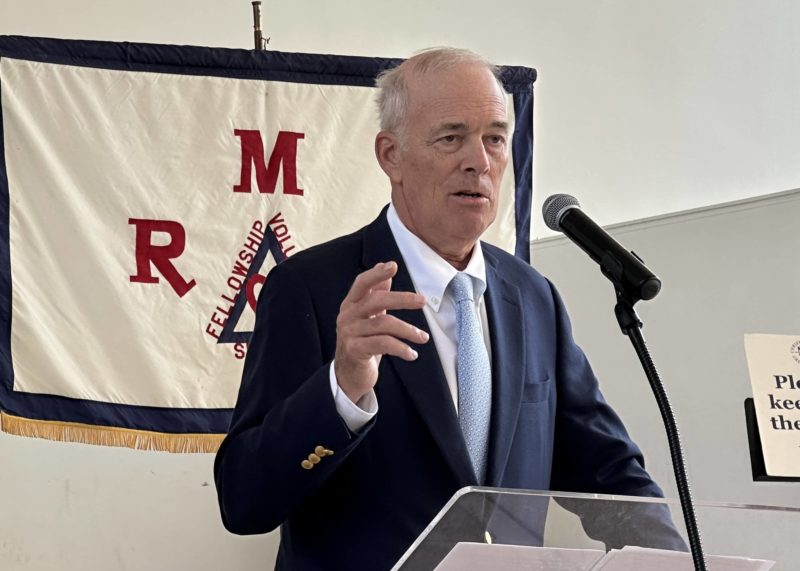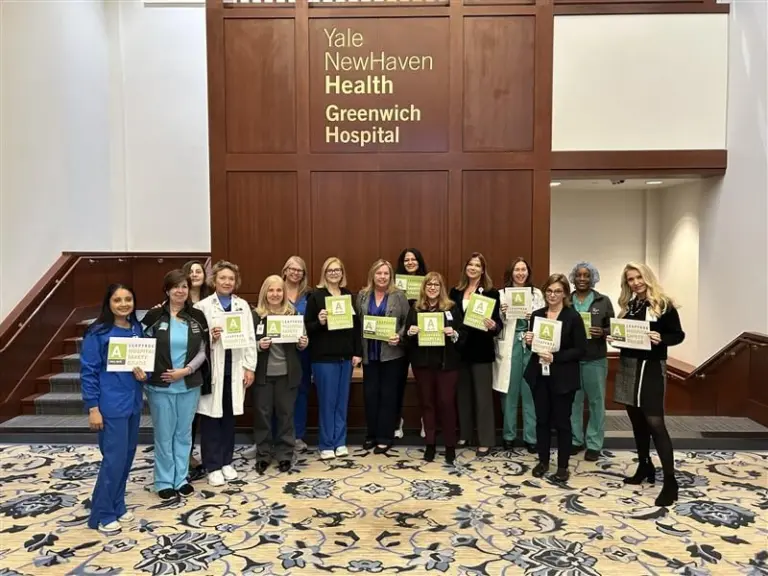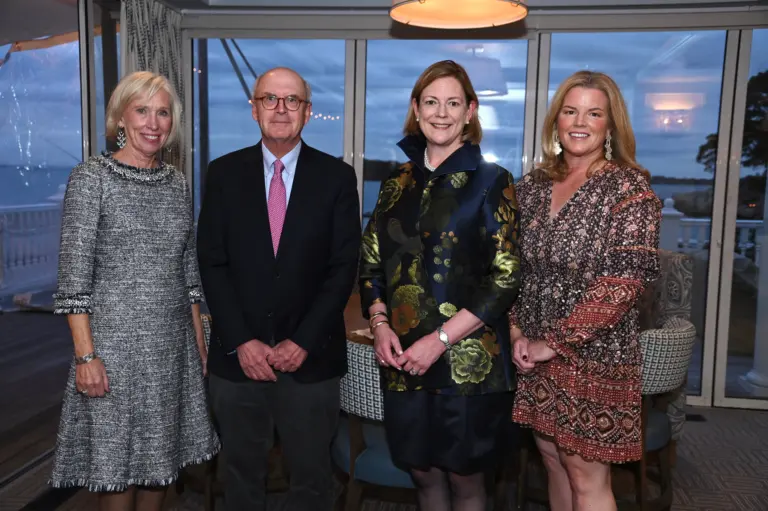
By Michael LaGamma
At the August 21 meeting of the Retired Men’s Association Bob Meaney introduced the week’s speaker, Bill Drake, a longtime Greenwich resident with an impressive educational and professional background. Drake served on Greenwich’s Board of Estimate and Taxation and was a member of the Representative Town Meeting.
Mr. Drake’s presentation delved into the life and accomplishments of General Lafayette, born into French aristocracy as Marie-Joseph Paul Yves Roch Gilbert du Motier de La Fayette. Despite his noble background, Lafayette’s early life was marked by tragedy, losing his parents and grandfather by age 13. This loss, however, left him with a considerable inheritance.
Inspired by the American Revolution, the 19-year-old Lafayette defied expectations and sailed to America in 1777 to join the fight against the British. Upon arrival, he sought out General George Washington in Philadelphia. Washington, 25 years his senior, became a father figure to Lafayette, who had lost his own father before the age of two.
Lafayette’s dedication to the American cause was quickly recognized. Congress awarded him the rank of Major General, and he demonstrated his bravery in the Battle of Brandywine, where he was wounded. After about 18 months of fighting, Lafayette returned to France in early 1779, where he fathered a son named George Washington Lafayette.
Returning to America in 1780, Lafayette played a crucial role in the Yorktown campaign, which led to the British surrender in 1781. He also formed a close relationship with Thomas Jefferson during this time.
Drake then shifted to Lafayette’s involvement in the French Revolution. His position was complex and contradictory – viewed as a revolutionary by the aristocracy due to his American involvement, yet still seen as an aristocrat by the lower classes. Lafayette played a key role in drafting the “Declaration of the Rights of Man,” a foundational document of modern France that echoed the principles of liberty and equality he had fought for in America.
As commander of the French National Guard, Lafayette found himself in a precarious position during the increasingly violent revolution. After the failed escape attempt of King Louis XVI, Lafayette fled to Austria to avoid execution, where he was imprisoned for five years. During this time, many of his wife Adrienne’s family members were executed by guillotine.
Following his release in 1797, Lafayette retired to his wife’s property, LaGrange, outside Paris, focusing on agriculture and gardening while maintaining some political involvement.
In 1824, at the invitation of President James Monroe and the U.S. Congress, Lafayette embarked on a grand tour of the United States. Declining the offer of a government vessel, he paid his own passage on a commercial ship, accompanied by his son George Washington Lafayette and a secretary.
Lafayette’s 13-month tour of America was marked by enthusiastic receptions across the country. He visited all 24 states, traveled on the newly-completed Erie Canal, and met with numerous past, present, and future U.S. presidents.
Drake then focused on Lafayette’s visit to Greenwich, which occurred on August 20, 1824, just five days after his arrival in New York. Drawing from a newspaper account written 60 years after the event, Drake described how Lafayette was met at the Byram bridge by a troop of Connecticut cavalry. A local contingent welcomed him with a speech acknowledging his contributions to American independence, particularly his role in the 1781 campaign against Cornwallis.
Lafayette’s brief stop in Greenwich included visits to the Knapp house and the home of Colonel Ebenezer Meade. The General inquired about any surviving members of the “old guard” from the Revolutionary War, but none were present due to the 40-year gap since the conflict. A 13-gun salute was fired in honor of the original 13 colonies.
Drake highlighted the gratitude shown to Lafayette during his tour. Congress granted him $200,000 and a township of land in Florida, though bureaucratic issues prevented Lafayette and his heirs from fully benefiting from the land grant.
After his return to France, Lafayette lived for another nine years at LaGrange. Drake concluded by noting that 2024 marks the 200th anniversary of Lafayette’s tour, suggesting that it may receive significant attention.
Throughout the talk, Drake emphasized Lafayette’s unique position as a bridge between American and French history. He portrayed Lafayette as a man deeply committed to the ideals of liberty and equality, who played crucial roles in both the American and French Revolutions. The talk also highlighted the deep affection and gratitude that Americans felt towards Lafayette, as evidenced by the enthusiastic receptions he received during his 1824 tour.
By focusing on Lafayette’s visit to Greenwich, Drake connected this broader historical narrative to local history, making it more tangible and relevant to his audience. The detailed account of the welcome ceremony at the Byram bridge and Lafayette’s stops in town provided a vivid picture of how this national tour touched even small communities like Greenwich.
Drake effectively combined elements of biography, military history, and local lore to create a comprehensive portrait of Lafayette and his significance to both American and French history. It served not only as a historical account but also as a reminder of the long-standing ties between the United States and France, embodied in the figure of General Lafayette.
The talk can be viewed by going to the RMA website at https://greenwichrma.org, and clicking on “Speakers.”
The RMA’s upcoming presentation, “Getting Russia Right: Why Russia Became an Adversary and How to Deal with It,” by Thomas Graham, is scheduled for 11 AM on Wednesday, September 4, 2024. US-Russian relations, now at their lowest point since the darkest days of the Cold War, continue to deteriorate. The Western narrative puts the blame squarely on Russian President Vladimir Putin: He took over a fitfully democratizing country in 1999 and put it on an authoritarian, imperialist track that culminated in the massive invasion of Ukraine in 2022.
The reality is more complicated. The United States also misread Russia and pursued policies that precluded the development of enduring constructive relations. No matter how the war in Ukraine ends, Russia is not going to disappear as a major challenge. Relations will remain competitive, as they have been for most of the past 150 years. The task for the United States is to develop what we might call a relationship of constructive competition. That is, while the two countries inevitably continue to compete for power and influence around the world, they also take steps to reduce to a minimum the risk of a direct military confrontation that could escalate to cataclysmic nuclear war and find ways to cooperate on urgent transnational challenges, such as climate change. Achieving this goal will require that we learn the lessons of the past and see Russia plainly, without ideological blinders and unwarranted sentiment.
Thomas Graham is a distinguished fellow at the Council on Foreign Relations. He is a cofounder of the Russian, East European and Eurasian studies program at Yale University, and a lecturer in global affairs and political science, teaching courses on U.S.-Russian relations and Russian foreign policy. From 2004 to 2007 he was special assistant and senior director for Russia on the National Security Council staff during which time he managed a U.S.-Russia strategic dialogue. From 2008 to 2021 he served as an advisor to Kissinger Associates. Previously he was a foreign service officer, with assignments including two tours of duty at the U.S. Embassy in Moscow. He holds a BA in Russian studies from Yale University and an MA in history and a PhD in political science from Harvard University.
To stream the presentation by Thomas Graham at 11 AM on Wednesday, September 4, click on https://bit.ly/30IBj21. This presentation will also be available on local public access TV channels, Verizon FIOS channel 24 and Optimum (Cablevision) channel 79. The public is also invited to attend the presentation in person at the First Presbyterian Church of Greenwich at 1 West Putnam Avenue.
Note: The views expressed in these presentations are those of the speakers. They are not intended to represent the views of the RMA or its members.
RMA speaker presentations are presented as a community service at no cost to in-person or Zoom attendees, regardless of gender. Any member of the public who would like to receive a weekly email announcement of future speakers should send a request to members@greenwichrma.org. The RMA urges all eligible individuals to consider becoming a member of our great organization, and thereby enjoy all the available fellowship, volunteer, and community service opportunities which the RMA offers to its members. For further information, go to https://greenwichrma.org/, or contact members@greenwichrma.org.




